2005 FORD EXPLORER check engine light
[x] Cancel search: check engine lightPage 283 of 320
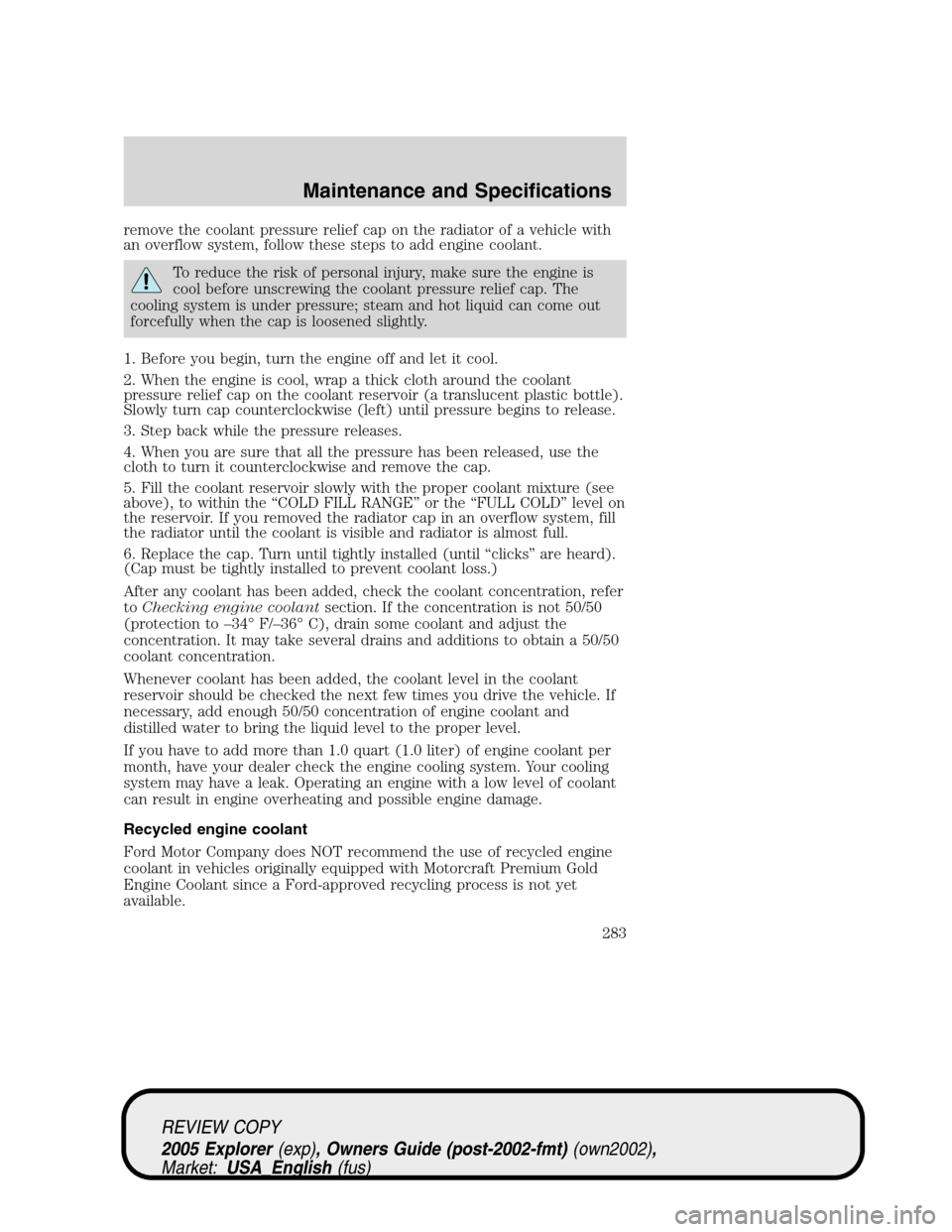
remove the coolant pressure relief cap on the radiator of a vehicle with
an overflow system, follow these steps to add engine coolant.
To reduce the risk of personal injury, make sure the engine is
cool before unscrewing the coolant pressure relief cap. The
cooling system is under pressure; steam and hot liquid can come out
forcefully when the cap is loosened slightly.
1. Before you begin, turn the engine off and let it cool.
2. When the engine is cool, wrap a thick cloth around the coolant
pressure relief cap on the coolant reservoir (a translucent plastic bottle).
Slowly turn cap counterclockwise (left) until pressure begins to release.
3. Step back while the pressure releases.
4. When you are sure that all the pressure has been released, use the
cloth to turn it counterclockwise and remove the cap.
5. Fill the coolant reservoir slowly with the proper coolant mixture (see
above), to within the “COLD FILL RANGE” or the “FULL COLD” level on
the reservoir. If you removed the radiator cap in an overflow system, fill
the radiator until the coolant is visible and radiator is almost full.
6. Replace the cap. Turn until tightly installed (until “clicks” are heard).
(Cap must be tightly installed to prevent coolant loss.)
After any coolant has been added, check the coolant concentration, refer
toChecking engine coolantsection. If the concentration is not 50/50
(protection to –34° F/–36° C), drain some coolant and adjust the
concentration. It may take several drains and additions to obtain a 50/50
coolant concentration.
Whenever coolant has been added, the coolant level in the coolant
reservoir should be checked the next few times you drive the vehicle. If
necessary, add enough 50/50 concentration of engine coolant and
distilled water to bring the liquid level to the proper level.
If you have to add more than 1.0 quart (1.0 liter) of engine coolant per
month, have your dealer check the engine cooling system. Your cooling
system may have a leak. Operating an engine with a low level of coolant
can result in engine overheating and possible engine damage.
Recycled engine coolant
Ford Motor Company does NOT recommend the use of recycled engine
coolant in vehicles originally equipped with Motorcraft Premium Gold
Engine Coolant since a Ford-approved recycling process is not yet
available.
REVIEW COPY
2005 Explorer(exp), Owners Guide (post-2002-fmt)(own2002),
Market:USA_English(fus)
Maintenance and Specifications
283
Page 285 of 320
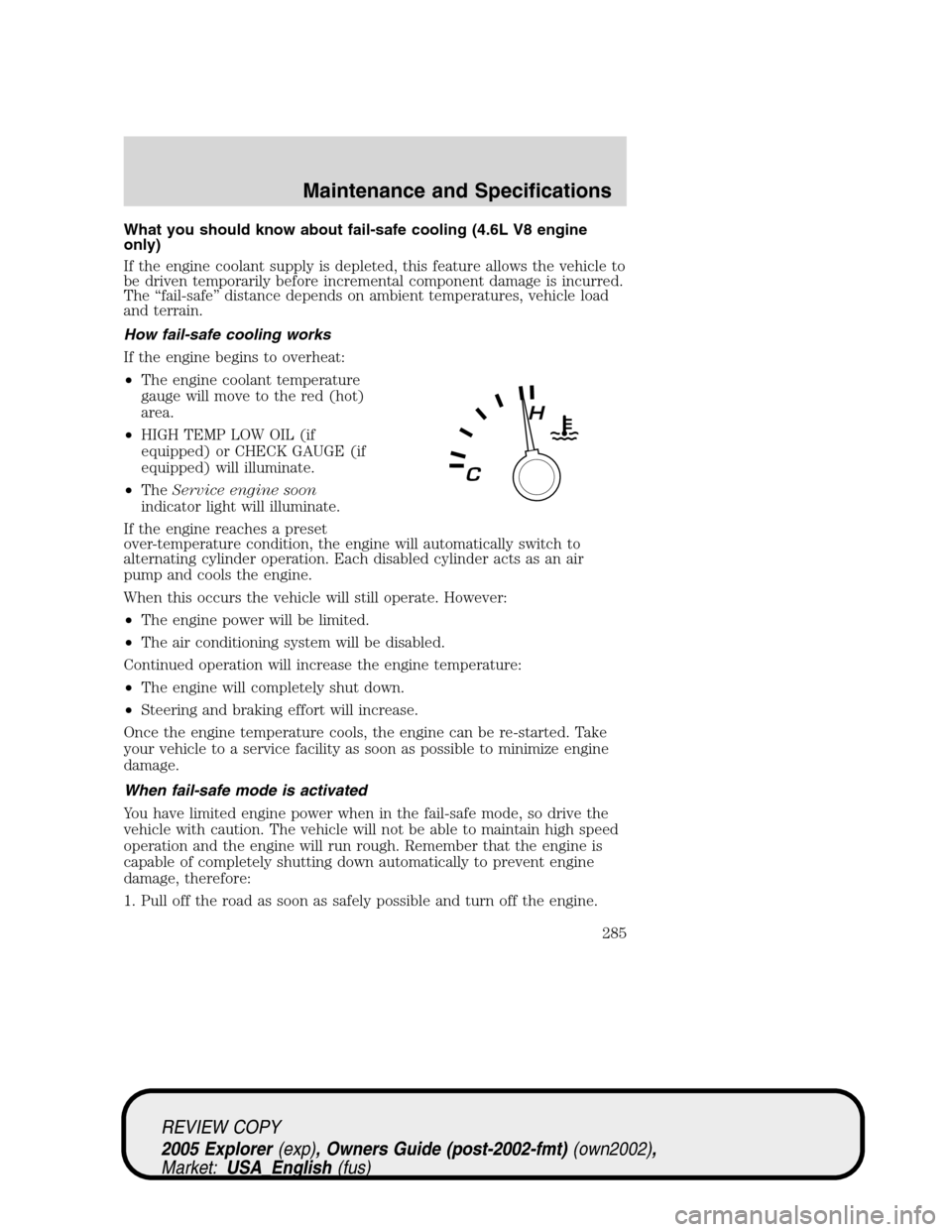
What you should know about fail-safe cooling (4.6L V8 engine
only)
If the engine coolant supply is depleted, this feature allows the vehicle to
be driven temporarily before incremental component damage is incurred.
The “fail-safe” distance depends on ambient temperatures, vehicle load
and terrain.
How fail-safe cooling works
If the engine begins to overheat:
•The engine coolant temperature
gauge will move to the red (hot)
area.
•HIGH TEMP LOW OIL (if
equipped) or CHECK GAUGE (if
equipped) will illuminate.
•TheService engine soon
indicator light will illuminate.
If the engine reaches a preset
over-temperature condition, the engine will automatically switch to
alternating cylinder operation. Each disabled cylinder acts as an air
pump and cools the engine.
When this occurs the vehicle will still operate. However:
•The engine power will be limited.
•The air conditioning system will be disabled.
Continued operation will increase the engine temperature:
•The engine will completely shut down.
•Steering and braking effort will increase.
Once the engine temperature cools, the engine can be re-started. Take
your vehicle to a service facility as soon as possible to minimize engine
damage.
When fail-safe mode is activated
You have limited engine power when in the fail-safe mode, so drive the
vehicle with caution. The vehicle will not be able to maintain high speed
operation and the engine will run rough. Remember that the engine is
capable of completely shutting down automatically to prevent engine
damage, therefore:
1. Pull off the road as soon as safely possible and turn off the engine.
REVIEW COPY
2005 Explorer(exp), Owners Guide (post-2002-fmt)(own2002),
Market:USA_English(fus)
Maintenance and Specifications
285
Page 289 of 320
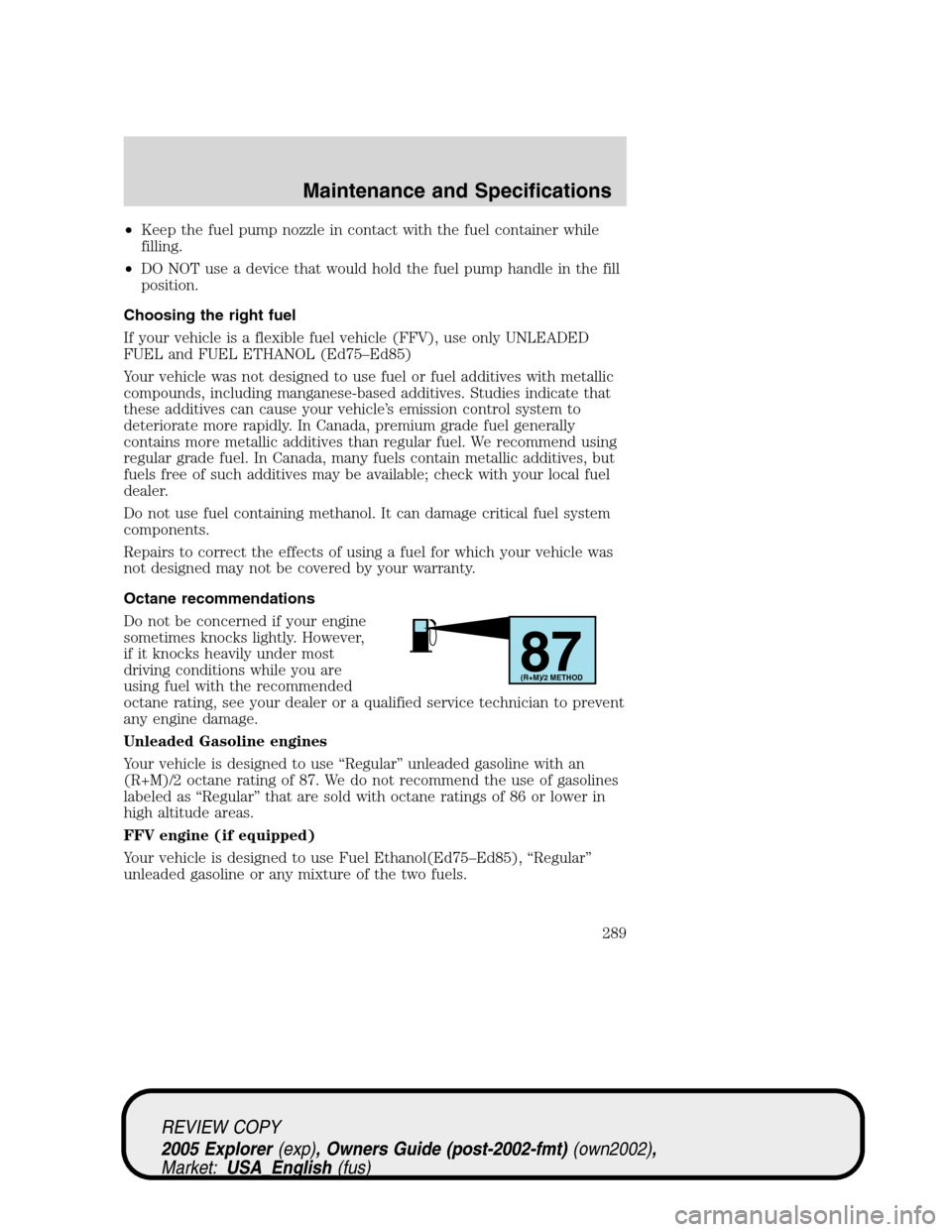
•Keep the fuel pump nozzle in contact with the fuel container while
filling.
•DO NOT use a device that would hold the fuel pump handle in the fill
position.
Choosing the right fuel
If your vehicle is a flexible fuel vehicle (FFV), use only UNLEADED
FUEL and FUEL ETHANOL (Ed75–Ed85)
Your vehicle was not designed to use fuel or fuel additives with metallic
compounds, including manganese-based additives. Studies indicate that
these additives can cause your vehicle’s emission control system to
deteriorate more rapidly. In Canada, premium grade fuel generally
contains more metallic additives than regular fuel. We recommend using
regular grade fuel. In Canada, many fuels contain metallic additives, but
fuels free of such additives may be available; check with your local fuel
dealer.
Do not use fuel containing methanol. It can damage critical fuel system
components.
Repairs to correct the effects of using a fuel for which your vehicle was
not designed may not be covered by your warranty.
Octane recommendations
Do not be concerned if your engine
sometimes knocks lightly. However,
if it knocks heavily under most
driving conditions while you are
using fuel with the recommended
octane rating, see your dealer or a qualified service technician to prevent
any engine damage.
Unleaded Gasoline engines
Your vehicle is designed to use “Regular” unleaded gasoline with an
(R+M)/2 octane rating of 87. We do not recommend the use of gasolines
labeled as “Regular” that are sold with octane ratings of 86 or lower in
high altitude areas.
FFV engine (if equipped)
Your vehicle is designed to use Fuel Ethanol(Ed75–Ed85), “Regular”
unleaded gasoline or any mixture of the two fuels.
87(R+M)/2 METHOD
REVIEW COPY
2005 Explorer(exp), Owners Guide (post-2002-fmt)(own2002),
Market:USA_English(fus)
Maintenance and Specifications
289
Page 296 of 320
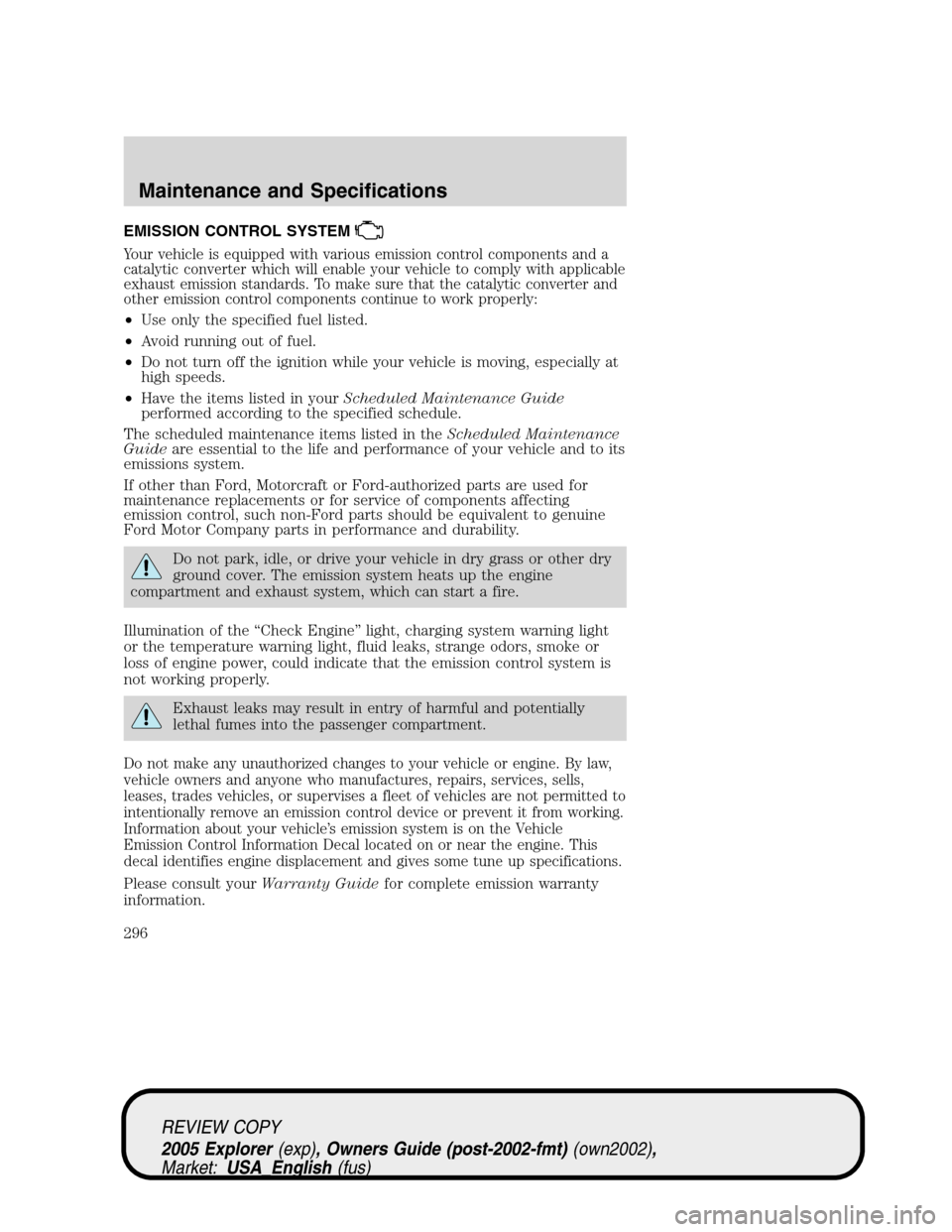
EMISSION CONTROL SYSTEM
Your vehicle is equipped with various emission control components and a
catalytic converter which will enable your vehicle to comply with applicable
exhaust emission standards. To make sure that the catalytic converter and
other emission control components continue to work properly:
•Use only the specified fuel listed.
•Avoid running out of fuel.
•Do not turn off the ignition while your vehicle is moving, especially at
high speeds.
•Have the items listed in yourScheduled Maintenance Guide
performed according to the specified schedule.
The scheduled maintenance items listed in theScheduled Maintenance
Guideare essential to the life and performance of your vehicle and to its
emissions system.
If other than Ford, Motorcraft or Ford-authorized parts are used for
maintenance replacements or for service of components affecting
emission control, such non-Ford parts should be equivalent to genuine
Ford Motor Company parts in performance and durability.
Do not park, idle, or drive your vehicle in dry grass or other dry
ground cover. The emission system heats up the engine
compartment and exhaust system, which can start a fire.
Illumination of the “Check Engine” light, charging system warning light
or the temperature warning light, fluid leaks, strange odors, smoke or
loss of engine power, could indicate that the emission control system is
not working properly.
Exhaust leaks may result in entry of harmful and potentially
lethal fumes into the passenger compartment.
Do not make any unauthorized changes to your vehicle or engine. By law,
vehicle owners and anyone who manufactures, repairs, services, sells,
leases, trades vehicles, or supervises a fleet of vehicles are not permitted to
intentionally remove an emission control device or prevent it from working.
Information about your vehicle’s emission system is on the Vehicle
Emission Control Information Decal located on or near the engine. This
decal identifies engine displacement and gives some tune up specifications.
Please consult yourWarranty Guidefor complete emission warranty
information.
REVIEW COPY
2005 Explorer(exp), Owners Guide (post-2002-fmt)(own2002),
Market:USA_English(fus)
Maintenance and Specifications
296
Page 297 of 320
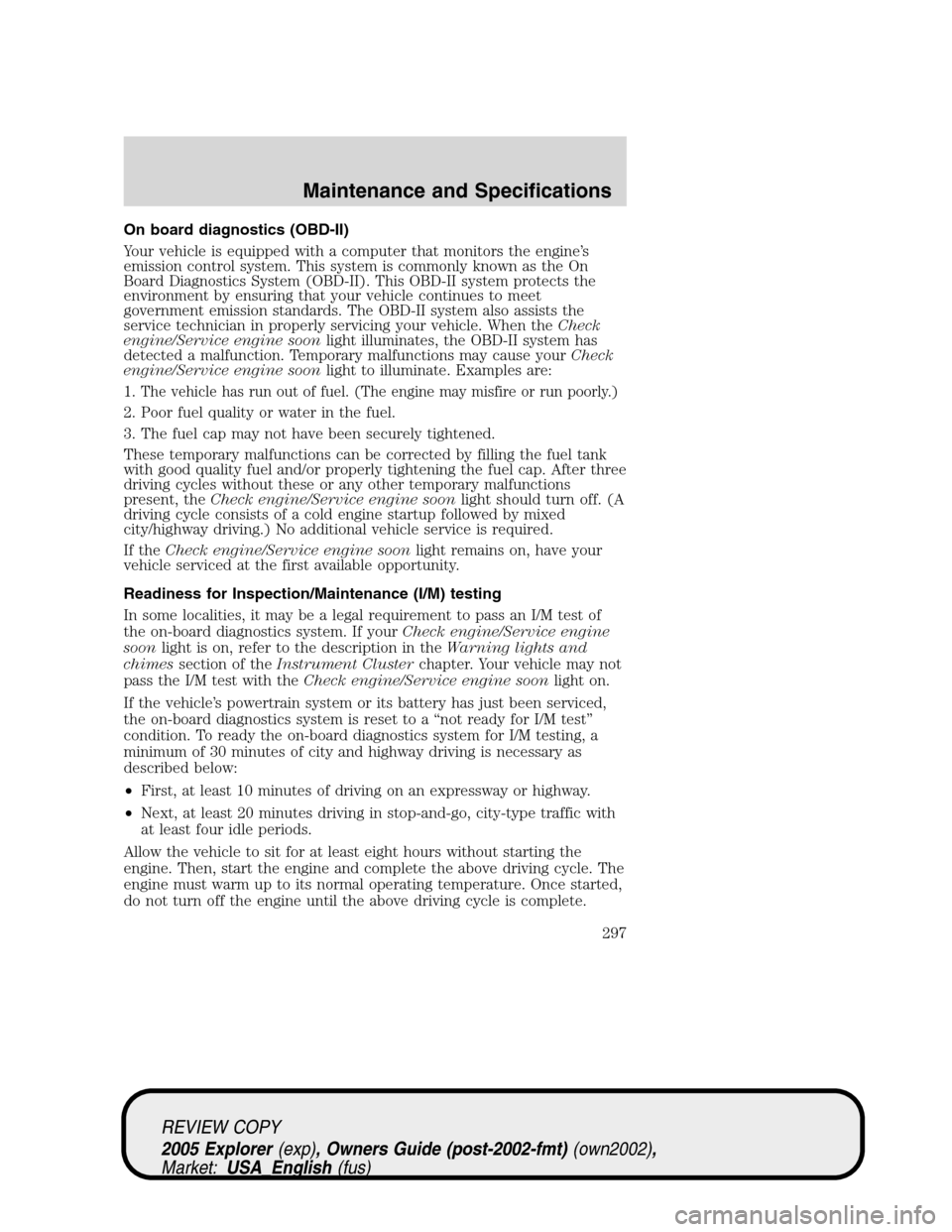
On board diagnostics (OBD-II)
Your vehicle is equipped with a computer that monitors the engine’s
emission control system. This system is commonly known as the On
Board Diagnostics System (OBD-II). This OBD-II system protects the
environment by ensuring that your vehicle continues to meet
government emission standards. The OBD-II system also assists the
service technician in properly servicing your vehicle. When theCheck
engine/Service engine soonlight illuminates, the OBD-II system has
detected a malfunction. Temporary malfunctions may cause yourCheck
engine/Service engine soonlight to illuminate. Examples are:
1.
The vehicle has run out of fuel. (The engine may misfire or run poorly.)
2. Poor fuel quality or water in the fuel.
3. The fuel cap may not have been securely tightened.
These temporary malfunctions can be corrected by filling the fuel tank
with good quality fuel and/or properly tightening the fuel cap. After three
driving cycles without these or any other temporary malfunctions
present, theCheck engine/Service engine soonlight should turn off. (A
driving cycle consists of a cold engine startup followed by mixed
city/highway driving.) No additional vehicle service is required.
If theCheck engine/Service engine soonlight remains on, have your
vehicle serviced at the first available opportunity.
Readiness for Inspection/Maintenance (I/M) testing
In some localities, it may be a legal requirement to pass an I/M test of
the on-board diagnostics system. If yourCheck engine/Service engine
soonlight is on, refer to the description in theWarning lights and
chimessection of theInstrument Clusterchapter. Your vehicle may not
pass the I/M test with theCheck engine/Service engine soonlight on.
If the vehicle’s powertrain system or its battery has just been serviced,
the on-board diagnostics system is reset to a “not ready for I/M test”
condition. To ready the on-board diagnostics system for I/M testing, a
minimum of 30 minutes of city and highway driving is necessary as
described below:
•First, at least 10 minutes of driving on an expressway or highway.
•Next, at least 20 minutes driving in stop-and-go, city-type traffic with
at least four idle periods.
Allow the vehicle to sit for at least eight hours without starting the
engine. Then, start the engine and complete the above driving cycle. The
engine must warm up to its normal operating temperature. Once started,
do not turn off the engine until the above driving cycle is complete.
REVIEW COPY
2005 Explorer(exp), Owners Guide (post-2002-fmt)(own2002),
Market:USA_English(fus)
Maintenance and Specifications
297
Page 313 of 320
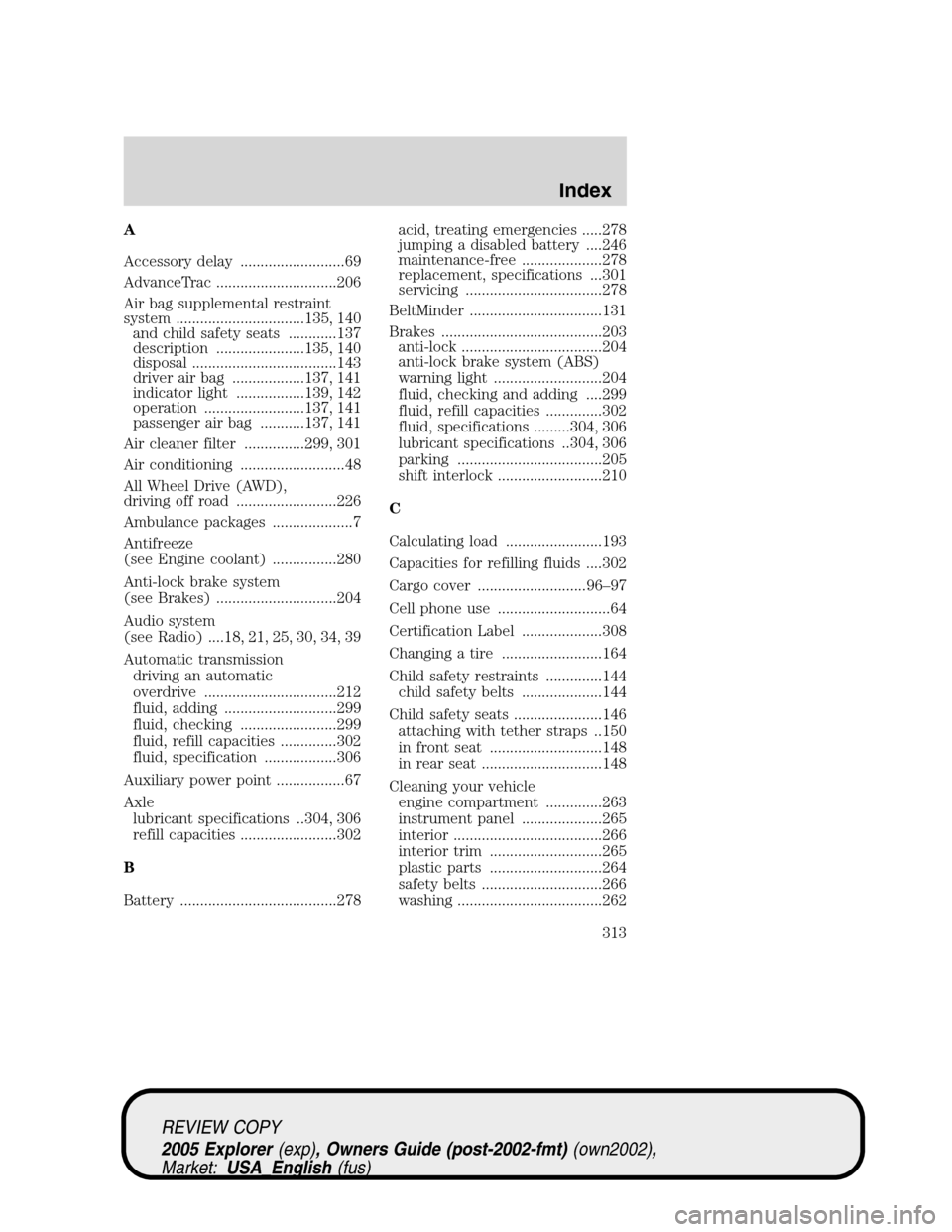
A
Accessory delay ..........................69
AdvanceTrac ..............................206
Air bag supplemental restraint
system ................................135, 140
and child safety seats ............137
description ......................135, 140
disposal ....................................143
driver air bag ..................137, 141
indicator light .................139, 142
operation .........................137, 141
passenger air bag ...........137, 141
Air cleaner filter ...............299, 301
Air conditioning ..........................48
All Wheel Drive (AWD),
driving off road .........................226
Ambulance packages ....................7
Antifreeze
(see Engine coolant) ................280
Anti-lock brake system
(see Brakes) ..............................204
Audio system
(see Radio) ....18, 21, 25, 30, 34, 39
Automatic transmission
driving an automatic
overdrive .................................212
fluid, adding ............................299
fluid, checking ........................299
fluid, refill capacities ..............302
fluid, specification ..................306
Auxiliary power point .................67
Axle
lubricant specifications ..304, 306
refill capacities ........................302
B
Battery .......................................278acid, treating emergencies .....278
jumping a disabled battery ....246
maintenance-free ....................278
replacement, specifications ...301
servicing ..................................278
BeltMinder .................................131
Brakes ........................................203
anti-lock ...................................204
anti-lock brake system (ABS)
warning light ...........................204
fluid, checking and adding ....299
fluid, refill capacities ..............302
fluid, specifications .........304, 306
lubricant specifications ..304, 306
parking ....................................205
shift interlock ..........................210
C
Calculating load ........................193
Capacities for refilling fluids ....302
Cargo cover ...........................96–97
Cell phone use ............................64
Certification Label ....................308
Changing a tire .........................164
Child safety restraints ..............144
child safety belts ....................144
Child safety seats ......................146
attaching with tether straps ..150
in front seat ............................148
in rear seat ..............................148
Cleaning your vehicle
engine compartment ..............263
instrument panel ....................265
interior .....................................266
interior trim ............................265
plastic parts ............................264
safety belts ..............................266
washing ....................................262
REVIEW COPY
2005 Explorer(exp), Owners Guide (post-2002-fmt)(own2002),
Market:USA_English(fus)
Index
Index
313
Page 315 of 320

idle speed control ...................278
lubrication
specifications ..................304, 306
refill capacities ........................302
service points ..................270–271
starting after a collision .........234
Engine block heater .................203
Engine oil ..................................273
checking and adding ..............273
dipstick ....................................273
filter, specifications ........276, 301
recommendations ...................276
refill capacities ........................302
specifications ..................304, 306
Exhaust fumes ..........................203
F
Fail safe cooling ........................285
Flexible Fuel Vehicle (FFV) ....286
Floor mats ...................................95
Fluid capacities .........................302
Foglamps .....................................53
Four-Wheel Drive vehicles .......217
driving off road ...............219, 226
indicator light .........................217
preparing to drive your
vehicle .....................................209
Fuel ............................................286
calculating fuel
economy ............................86, 292
cap ...........................................291
capacity ...................................302
choosing the right fuel ...........289
comparisons with EPA fuel
economy estimates .................295
detergent in fuel .....................291
filling your vehicle with
fuel ...........................286, 291–292filter, specifications ........292, 301
fuel pump shut-off switch .....234
improving fuel economy ........292
octane rating ...........289, 306–307
quality ......................................290
running out of fuel .................291
safety information relating to
automotive fuels .....................286
Fuel - flex fuel vehicle
(FFV) .................................286, 289
Fuses ..................................235, 237
G
Garage door opener ....................66
Garage Door Opener
(see Homelink wireless control
system) ........................................77
Gas cap (see Fuel cap) ............291
Gas mileage
(see Fuel economy) .................292
Gauges .........................................15
GAWR (Gross Axle Weight
Rating)
calculating ...............................193
GVWR (Gross Vehicle Weight
Rating)
calculating ...............................193
H
Hazard flashers .........................234
Head restraints .........................112
Headlamps
aiming ........................................55
bulb specifications ....................57
daytime running lights .............53
flash to pass ..............................54
high beam .................................54
REVIEW COPY
2005 Explorer(exp), Owners Guide (post-2002-fmt)(own2002),
Market:USA_English(fus)
Index
315
Page 316 of 320

Heating
heating and air conditioning
system .................................46, 48
Homelink wireless control
system ..........................................77
Hood ..........................................269
I
Ignition .......................200, 306–307
Infant seats
(see Safety seats) .....................146
Inspection/maintenance (I/M)
testing ........................................297
Instrument panel
cleaning ...................................265
cluster ........................................10
J
Jack ....................................164, 167
positioning .......................164, 169
storage .....................164, 166–167
Jump-starting your vehicle ......246
K
Keyless entry system ...............105
autolock ...................................107
Keys
positions of the ignition .........200
L
Lamps
bulb replacement
specifications chart ..................57
daytime running light ...............53
fog lamps ...................................53
interior lamps ...........................56Liftgate ................................95, 102
Lights, warning and indicator ....10
anti-lock brakes (ABS) ..........204
Limited-slip axle .......................217
Load limits .................................187
Loading instructions .................193
Locks
autolock ...................................107
childproof ................................100
doors ..........................................99
Lubricant specifications ...304, 306
Lug nuts ....................................172
Luggage rack ...............................97
Lumbar support,
seats ...........................114, 116–117
M
Message center ...........................83
english/metric button ...............89
system check button ................89
warning messages .....................90
Mirrors ...................................67, 70
automatic dimming rearview
mirror ........................................70
fold away ...................................70
heated ........................................70
side view mirrors (power) .......69
Moon roof ....................................76
Motorcraft parts ................292, 301
O
Octane rating ............................289
Oil (see Engine oil) ..................273
P
Parking brake ............................205
REVIEW COPY
2005 Explorer(exp), Owners Guide (post-2002-fmt)(own2002),
Market:USA_English(fus)
Index
316